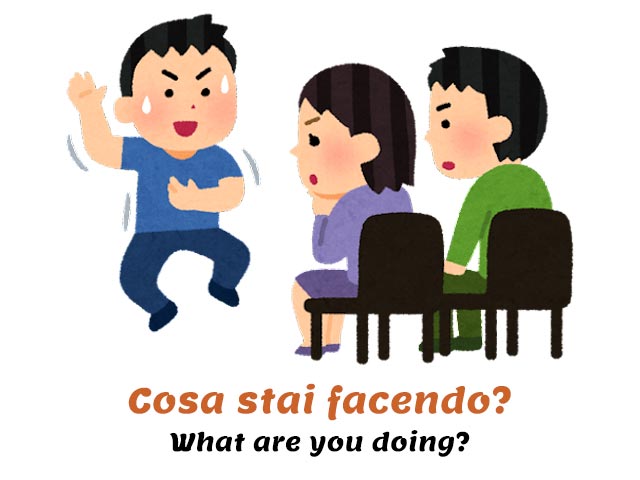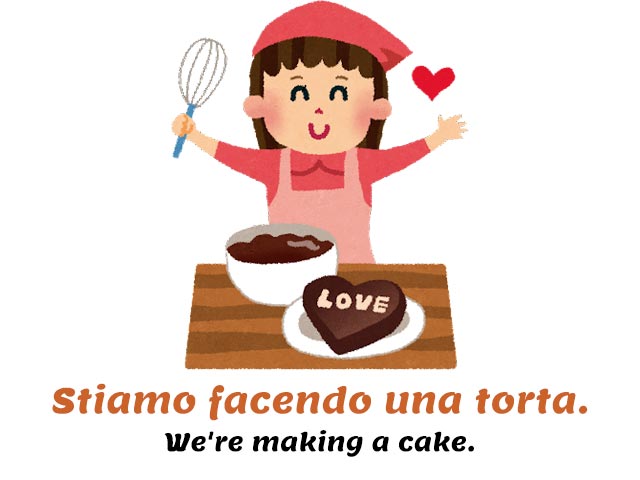How do you say it in Italian?
Cosa stai facendo?
| Words you should know | Cosa (what) + stare (to stay) + fare (to do) |
| When to use this | With 1 person you’re familiar with |
| When NOT to use this | With strangers and groups |
Cosa stai facendo?
What are you doing? (singular)
For example, you can say…
Cosa stai facendo? – Sto leggendo un libro.
What are you doing? – I’m reading a book.
Cosa stai facendo? – Sto pulendo la cucina.
What are you doing? – I’m cleaning the kitchen.

The gerund tense in Italian uses the verb stare, to stay, while English uses to be. Stai is basically the second person singular present conjugation of stare (that’s a mouthful!).
We then have the gerund form of the verb fare, which is facendo.
Fare, facendo, fatto
To do, doing, done
Usually, to create the gerund form of a verb you simply append the endings -ando/endo to the root form of the verb, also known as the stem.
What’s the stem of a verb?
Italian verbs in the infinitive end in -ARE, -ERE and -IRE.
Cut out this part and you will be left with the root verb.
Examples:
tremare ➡️ trem-
piovere ➡️ piov-
cucire ➡️ cuc-
Italian verb endings for every tense are added to these root forms of the verb.
Verbs in -are will take -ando, and verbs in -ere and -ire will take -endo.
For example, tremare (to tremble) will become tremando (trembling), piovere (to rain) will become piovendo (raining).
Fare is an irregular verb and its gerund form is NOT fando, but facendo.
This is why you’ll translate what are you doing in Italian as cosa stai facendo?.

Cosa state facendo?
| When to use this | With a group of people |
| When NOT to use this | With strangers (doh!) and 1 person at a time |
Cosa state facendo?
What are you doing? (plural)
In Italian, unlike English, there are two kinds of “you”. There is a singular “you” and then there is a plural “you”. If you’re speaking to a group, you’ll need to conjugate any verb or pronoun accordingly, and don’t forget the gender!
For example, you can say…
Ragazzi, cosa state facendo? – Stiamo giocando.
Guys, what are you doing? – We’re playing.
Cosa state facendo? – Stiamo facendo una torta.
What are you doing? – We’re making a cake.

Cosa sta facendo?
In Italian, unlike English, there are two kinds of “you”. There is a singular “you” and then there is a plural “you”. If you’re speaking to a group, you’ll need to conjugate any verb or pronoun accordingly.
Cosa sta facendo?
What are you doing? (formal)
Scusi, che cosa sta facendo?
Excuse me, what are you doing?
Che cosa…?
We’ve covered three ways to say what are you doing in Italian so far:
- cosa stai facendo?
- cosa state facendo?
- cosa sta facendo?
Maybe you already know that the translation for what, cosa, can also be rendered in Italian as che cosa. These are totally interchangeable, so you can pick whichever one you like.
The only difference between cosa and che cosa is that cosa alone can also mean thing, but che cosa can only mean what.
Che cosa stai facendo?
What are you doing? (singular, informal)
In colloquial speech, you can even do without cosa entirely and only ask che stai facendo?.
Che stai facendo?
What are you doing? (singular, informal)
Che state facendo?
What are you doing? (plural)
In both informal and formal speech, it’s also very common to even get rid of the gerund form and simply conjugate fare in the present tense. The Italian present tense can also translate the English present continuous tense.
Che fai? Che fate? Che fa?
What are you doing? (singular, plural, formal)
More free Italian resources
You might want to keep learning Italian online with these free Italian resources:
❤️ If you liked this lesson on how to say what are you doing in Italian, share it with your friends!



Very helpful